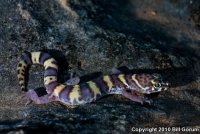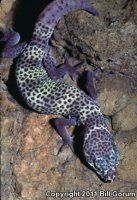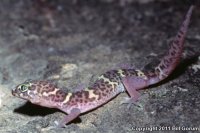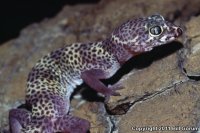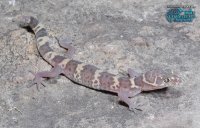| Range: |
 |
| Other Names: |
|
| Description: |
Slender body with large head and large eyes with vertical pupils and movable eyelids. Small granular scales. Slender toes without pads. Thick tail equal in length to the head and body. Females grow larger than males. Pinkish brown ground color with alternating cross bands of brown and pale yellow. Dark and light colored blotches and spots on body create mottled look, especially with age. Adult Coleonyx brevis may reach lengths of 10-12 cm (4-4.75 in), including tail. |
| Similar Species: |
The Western Banded Gecko usually has sevenor more preanal pores that are continuous across the ventral midline, usually lacks the degree of dark dorsal mottling and speckling, retaining more of a banded pattern and the cloacal bones of males are narrow and pointed. The Mediterranean Gecko has conspicuously enlarged dorsal tubercles, expanded toepads and lacks functional eyelids. |
| Venom: |
None. |
| Habitat: |
The Texas banded gecko is a terrestrial species that lives in dry, rocky areas, where it can be found in canyons and crevices, as well as under rocks and fallen yuccas. |
| Behavior: |
Nocturnal, This nocturnal gecko remains under cover during daylight hours and exits at dusk. Texas banded geckos can commonly be seen on roadways at night as it forages for insects and spiders. This species of gecko emits squeaks when handled. They will lose their tails when in danger and regrow them. They will also eat their shed skin! |
| Hibernation: |
|
| Reproduction: |
Breeding is not well described, but probably occurs for a few months in late spring with one or two eggs being laid. Juveniles have a distinctive chocolate brown bands that develop light areas as they become adults. |
| Diet: |
Small arthropods including: grasshoppers, moths, termites, spiders, ants, solpugids, crickets, cockroaches, cicadas, lyceid bugs, blister beetles and larvae of various insects. |
Adapted from account on herpsoftexas.org
Sources:



|


